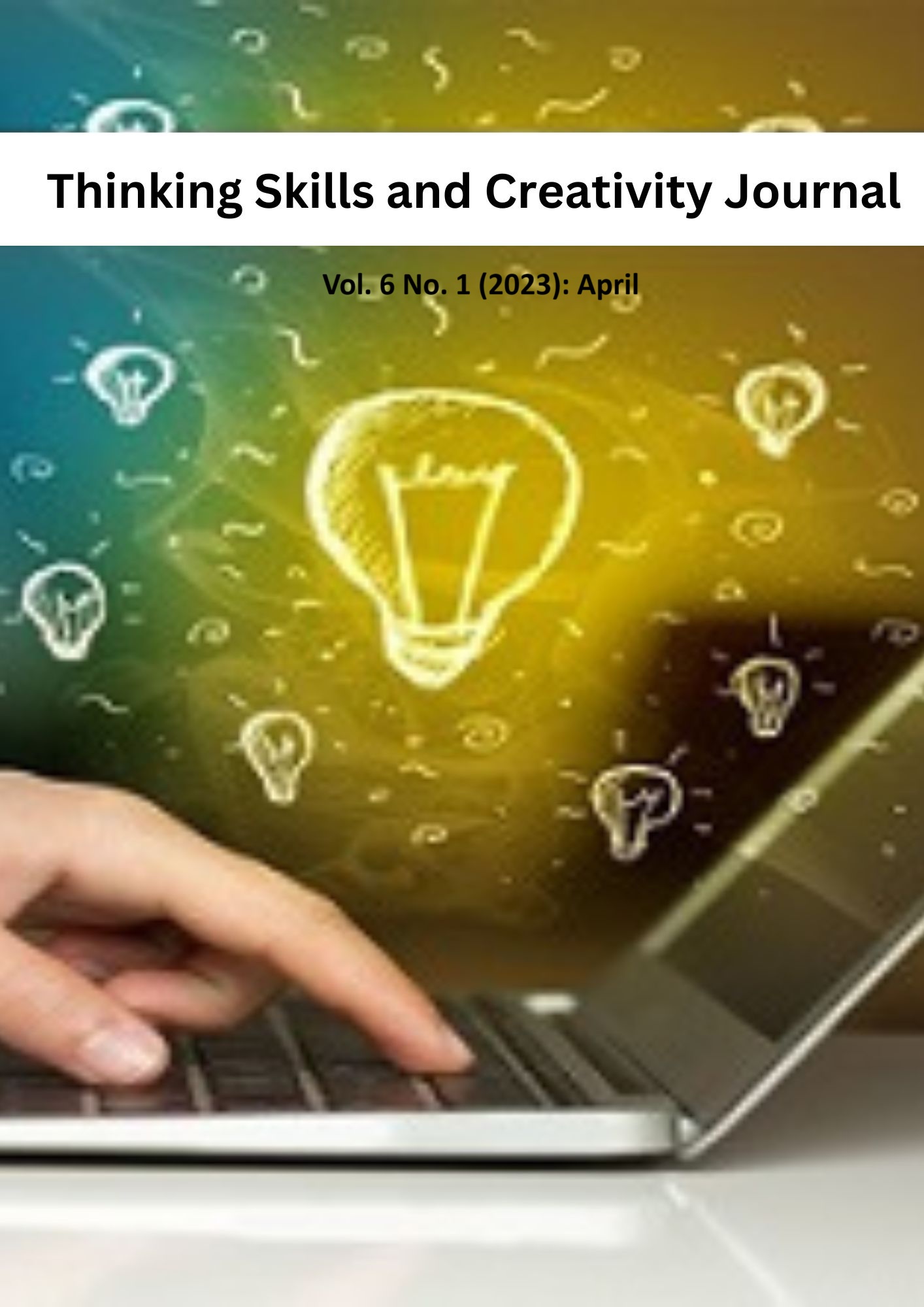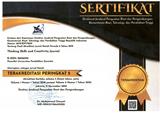Creativity in Higher Education: The Effect of Personality on Students’ Creative Thinking Skills
DOI:
https://doi.org/10.23887/tscj.v6i1.54916Keywords:
Creative personality, creative thinking skill, perseverance in learning, students higher educationAbstract
Creative thinking is an essential skill to be developed in college students. The importance of these skills is not in line with the existing student creativity in higher education. Several studies on students show low levels of these skills. A creative personality is a factor that influences these skills. This study aims to test the influence of creative personality on creative thinking skills. The research uses a quantitative approach with associative design. The research subjects were 90 (ninety) students who were randomly selected by considering the proportion of three state universities in East Java. Data were obtained by measuring creative personality and creative thinking skills through the creative personality scale and creative thinking test. The data were analyzed through regression analysis techniques. Testing is performed simultaneously and partially. The results show that a creative personality affects creative thinking skills. Perseverance is the most dominant factor in influencing students' creative thinking skills. The results of this study imply that the development of students’ creative thinking should be in line with the development of their creative personality.
References
Abd-Elsamad, F. I., Zaki, M. A., Mahmoud, M. K., & Sayed, M. A. K. (2021). Psychometric properties of the Academic Perseverance Scale for pupils with learning difficulties in primary school. Journal of Research in Education and Psychology, 36(1), 383–402. https://doi.org/10.21608/mathj.2021.135977. DOI: https://doi.org/10.21608/mathj.2021.135977
An, D., Song, Y., & Carr, M. (2016). A comparison of two models of creativity: Divergent thinking and creative expert performance. Personality and Individual Differences, 90, 78–84. https://doi.org/10.1016/j.paid.2015.10.040. DOI: https://doi.org/10.1016/j.paid.2015.10.040
Aziz, R., Surur, M., Lestari, S., Hotifah, Y., & Naim, N. (2022). Lecturer-Student Collaboration in Higher Education as a Solution for Fostering Student’s Creative Personality. Jurnal Pendidikan Progresif, 12(1), 241–253. https://doi.org/10.23960/jpp.v12.i1.202219. DOI: https://doi.org/10.23960/jpp.v12.i1.202219
Barnes, A. (2021). Enjoyment in learning mathematics: its role as a potential barrier to children’s perseverance in mathematical reasoning. Educational Studies in Mathematics, 106(1), 45–63. https://doi.org/10.1007/s10649-020-09992-x. DOI: https://doi.org/10.1007/s10649-020-09992-x
Campbell, P., Witenko, C., & Dzierba, A. L. (2020). Perseverance in a pandemic: A unique pharmacy residency learning experience. American Journal of Health-System Pharmacy, 77(18), 1459–1460. https://doi.org/10.1093/ajhp/zxaa206. DOI: https://doi.org/10.1093/ajhp/zxaa206
Catarino, P. (2019). Cooperative learning on promoting creative thinking and mathematical creativity in higher education. REICE. Revista Iberoamericana Sobre Calidad, Eficacia y Cambio En Educacion, 17(3), 5–22. https://doi.org/10.15366/reice2019.17.3.001. DOI: https://doi.org/10.15366/reice2019.17.3.001
Chen, P., & Zhang, J. (2020). Development of Chinese junior high school students’ creative potential: Within-person and between-person effects of student–student support and need for cognition. Frontiers in Psychology, 11, 552831. https://doi.org/10.3389/fpsyg.2020.552831. DOI: https://doi.org/10.3389/fpsyg.2020.552831
Chiu, Y. T. H., Lee, W. I., & Chen, T. H. (2014). Environmentally responsible behavior in ecotourism: Antecedents and implications. Tourism Management, 40, 321–329. https://doi.org/10.1016/j.tourman.2013.06.013. DOI: https://doi.org/10.1016/j.tourman.2013.06.013
Conradty, C., & Bogner, F. X. (2019). From STEM to STEAM: Cracking the code? How creativity & motivation interacts with inquiry-based learning. Creativity Research Journal, 31(3), 284–295. https://doi.org/10.1080/10400419.2019.1641678. DOI: https://doi.org/10.1080/10400419.2019.1641678
Didin, W., & Wiji, L. Z. (2020). The implementation of project-based learning approach in students’ creativity programs in indonesia. Humanities & Social Sciences Reviews, 8(3), 702–708. https://doi.org/10.18510/HSSR.2020.8375. DOI: https://doi.org/10.18510/hssr.2020.8375
Duenyas, D. L., & Perkins, R. (2021). Making Space for a Makerspace in Counselor Education: The Creative Experiences of Counseling Graduate Students. Journal of Creativity in Mental Health, 16(4), 537–547. https://doi.org/10.1080/15401383.2020.1790456. DOI: https://doi.org/10.1080/15401383.2020.1790456
Ebadi, S., Weisi, H., & Khaksar, Z. (2018). Developing an Iranian ELT context-specific grit instrument. Journal of Psycholinguistic Research, 47, 975–997. https://doi.org/10.1007/s10936-018-9571-x. DOI: https://doi.org/10.1007/s10936-018-9571-x
Fan, M., & Cai, W. (2022). How does a creative learning environment foster student creativity? An examination on multiple explanatory mechanisms. Current Psychology, 41(7), 4667–4676. https://doi.org/10.1007/s12144-020-00974-z. DOI: https://doi.org/10.1007/s12144-020-00974-z
García-García, C., Chulvi, V., Royo, M., Gual, J., & Felip, F. (2019). Does the work environment affect designers’ creativity during the creative phase depending on their personality profile? Thinking Skills and Creativity, 33, 100578. https://doi.org/10.1016/j.tsc.2019.100578. DOI: https://doi.org/10.1016/j.tsc.2019.100578
Göçen, G. (2019). The effect of creative writing activities on elementary school students’ creative writing achievement, writing attitude and motivation. Journal of Language and Linguistic Studies, 15(3), 1032–1044. https://doi.org/10.17263/jlls.631547. DOI: https://doi.org/10.17263/jlls.631547
Gutterman, D., & Aafjes Van-Doorn, K. (2022). An Exploration of the Intersection Between Creativity and Psychotherapy. Creativity Research Journal, 1(1), 1–12. https://doi.org/10.1080/10400419.2022.2127566. DOI: https://doi.org/10.1080/10400419.2022.2127566
Holis, A. (2017). Peranan Keluarga/Orang Tua dan Sekolah dalam mengembangkan kreativitas anak usia dini. Jurnal Pendidikan UNIGA, 1(1), 22–43. https://doi.org/10.52434/jp.v1i1.8.
Hsia, L. H., Lin, Y. N., & Hwang, G. J. (2021). A creative problem solving‐based flipped learning strategy for promoting students’ performing creativity, skills and tendencies of creative thinking and collaboration. British Journal of Educational Technology, 52(4), 1771–1787. https://doi.org/10.1111/bjet.13073. DOI: https://doi.org/10.1111/bjet.13073
Huang, N. T., Chang, Y. S., & Chou, C. H. (2020). Effects of creative thinking, psychomotor skills, and creative self-efficacy on engineering design creativity. Thinking Skills and Creativity, 37, 100695. https://doi.org/10.1016/j.tsc.2020.100695. DOI: https://doi.org/10.1016/j.tsc.2020.100695
Humble, S., Dixon, P., & Mpofu, E. (2018). Factor structure of the Torrance Tests of Creative Thinking Figural Form A in Kiswahili speaking children: Multidimensionality and influences on creative behavior. Thinking Skills and Creativity, 27, 33–44. https://doi.org/10.1016/j.tsc.2017.11.005. DOI: https://doi.org/10.1016/j.tsc.2017.11.005
Ismail, N. S., Harun, J., Zakaria, M. A. Z. M., & Salleh, S. M. (2018). The effect of Mobile problem-based learning application DicScience PBL on students’ critical thinking. Thinking Skills and Creativity, 28, 177–195. https://doi.org/10.1016/j.tsc.2018.04.002. DOI: https://doi.org/10.1016/j.tsc.2018.04.002
Jaffe, M., Kelly, E., Williams, A., Beroiza, A., DiGiacomo, M., & Kafle, M. (2021). Collaboration and ‘potential space’: creative play in the writing alliance. Teaching in Higher Education, 1(1), 1–16. https://doi.org/10.1080/13562517.2021.1989581. DOI: https://doi.org/10.1080/13562517.2021.1989581
Jamaluddin, A. B., Zubaidah, S., Mahanal, S., & Gofur, A. (2021). Character, creative thinking and learning achievement in higher education: How they are correlated. AIP Conference Proceedings, 2330. https://doi.org/10.1063/5.0043184. DOI: https://doi.org/10.1063/5.0043184
Jankowska, D. M., & Karwowski, M. (2019). Family factors and development of creative thinking. Personality and Individual Differences, 142, 202–206. https://doi.org/10.1016/j.paid.2018.07.030. DOI: https://doi.org/10.1016/j.paid.2018.07.030
Kao, C. (2016). Analogy’s straddling of analytical and creative thinking and relationships to Big Five Factors of personality. Thinking Skills and Creativity, 19, 26–37. https://doi.org/10.1016/j.tsc.2015.08.001. DOI: https://doi.org/10.1016/j.tsc.2015.08.001
Kiraga, M. K., Mason, N. L., Uthaug, M. V., van Oorsouw, K. I., Toennes, S. W., Ramaekers, J. G., & Kuypers, K. P. (2021). Persisting Effects of Ayahuasca on Empathy, Creative Thinking, Decentering, Personality, and Well-Being. Frontiers in Pharmacology, 12, 721537. https://doi.org/10.3389/fphar.2021.721537. DOI: https://doi.org/10.3389/fphar.2021.721537
Lee, S. Y., & Min, J. (2016). The Profiles of Creative Potential and Personality Characteristics of Adult Professionals. Creativity Research Journal, 28(3), 298–309. https://doi.org/10.1080/10400419.2016.1195634. DOI: https://doi.org/10.1080/10400419.2016.1195634
Liu, H., Wang, F. X., & Yang, X. Y. (2015). More dialectical thinking, less creativity? the relationship between dialectical thinking style and creative personality: The case of China. PLoS ONE, 10(4). https://doi.org/10.1371/journal.pone.0122926. DOI: https://doi.org/10.1371/journal.pone.0122926
Malele, V. (2021). From Science, Technology and Innovation to Creativity, Innovation and Entrepreneurship Indicators’ Framework for the Academic Promotion with Impact on Socio-Economic Development. Journal of Scientometric Research, 10(3), 373–379. https://doi.org/10.5530/jscires.10.3.55 DOI: https://doi.org/10.5530/jscires.10.3.55
Murtianto, Y. H., Rahmawati, N. D., & Apriana, D. (2020). Creative thinking profile of students in the completion of the area of 2D-shapes reviewed from the type of personality of Myer-Briggs dimension. Journal of Physics, 1663(1), 012013. https://doi.org/10.1088/1742-6596/1663/1/012013. DOI: https://doi.org/10.1088/1742-6596/1663/1/012013
Prastiti, T. D. (2020). Problem-based learning on the learning perseverance of indonesian senior high school students in solving mathematical problems. Bolema - Mathematics Education Bulletin, 34(68), 1206–1220. https://doi.org/10.1590/1980-4415v34n68a17. DOI: https://doi.org/10.1590/1980-4415v34n68a17
Puspita, D. A., Muchlas, M., & Kuat, T. (2020). The Implementation of Teaching Factory to Improve Student Interest in Entrepreneurship at Multimedia Competencies. Journal of Technology and Humanities, 1(2), 42–50. https://doi.org/10.53797/jthkkss.v1i2.5.2020.
Rizki, M. A., Ruslana, R., & Artika, W. (2020). Potensi Kreatif dan Pengukurannya dari Perspektif Psikologi. Al-Din: Jurnal Dakwah Dan Sosial Keagamaan, 6(2). https://doi.org/10.35673/ajdsk.v6i2.1131. DOI: https://doi.org/10.35673/ajdsk.v6i2.1131
Robino, A. E., Corrigan, V. K., Anderson, B., Werre, S., Farley, J. P., Marmagas, S. W., & Buechner-Maxwell, V. (2021). College Student Mental Health in an Animal-Assisted Intervention Program: A Preliminary Study. Journal of Creativity in Mental Health, 16(1), 49–58. https://doi.org/10.1080/15401383.2020.1757002. DOI: https://doi.org/10.1080/15401383.2020.1757002
Roth, T., Conradty, C., & Bogner, F. X. (2022). Testing creativity and personality to explore creative potentials in the science classroom. Research in Science Education, 52(4), 1293–1312. https://doi.org/10.1007/s11165-021-10005-x. DOI: https://doi.org/10.1007/s11165-021-10005-x
Said-Metwaly, S., Fernández-Castilla, B., Kyndt, E., & Van den Noortgate, W. (2018). The factor structure of the Figural Torrance Tests of Creative Thinking: A meta-confirmatory factor analysis. Creativity Research Journal, 30(4), 352–360. https://doi.org/10.1080/10400419.2018.1530534.
Said-Metwaly, S., Kyndt, E., & Van den Noortgate, W. (2020). The factor structure of the Verbal Torrance Test of Creative Thinking in an Arabic context: Classical test theory and multidimensional item response theory analyses. Thinking Skills and Creativity, 35, 100609. https://doi.org/10.1016/j.tsc.2019.100609. DOI: https://doi.org/10.1016/j.tsc.2019.100609
Said-Metwaly, S., Van den Noortgate, W., & Barbot, B. (2021). Torrance test of creative thinking-verbal, Arabic version: Measurement invariance and latent mean differences across gender, year of study, and academic major. Thinking Skills and Creativity, 39, 100768. https://doi.org/10.1016/j.tsc.2020.100768. DOI: https://doi.org/10.1016/j.tsc.2020.100768
Sari, H. I., Munawaroh, M., & Raharjo, H. (2020). Analysis of Student’s Creative Thinking Ability in Mathematical Problem Solving in Terms of Extrovert and Introvert Personality Types. Eduma: Mathematics Education Learning and Teaching, 9(1), 34–42. https://doi.org/10.24235/eduma.v9i1.6153. DOI: https://doi.org/10.24235/eduma.v9i1.6153
Tang, M. (2019). Fostering creativity in intercultural and interdisciplinary teams: The VICTORY Model. Frontiers in Psychology, 10, 2020. https://doi.org/10.3389/fpsyg.2019.02020. DOI: https://doi.org/10.3389/fpsyg.2019.02020
Van Ngo, T. (2022). Students’ Perceptions of Perseverance in Online Learning Through the Flipped Classroom Model: A Case Study in a Physics Course. International Journal of Online Pedagogy and Course Design (IJOPCD), 12(1), 1–17. https://doi.org/10.4018/IJOPCD.311439. DOI: https://doi.org/10.4018/IJOPCD.311439
Wahyuni, S., & Husein, S. (2019). Physics Learning Devices based on Guided Inquiry with Experiment to Improve Students’ Creativity. Journal of Physics: Conference Series, 1233(1). https://doi.org/10.1088/1742-6596/1233/1/012034. DOI: https://doi.org/10.1088/1742-6596/1233/1/012034
Wilburne, J. M., & Dause, E. (2017). Teaching self-regulated learning strategies to low-achieving fourth-grade students to enhance their perseverance in mathematical problem solving. Investigations in Mathematics Learning, 9(1), 38–52. https://doi.org/10.1080/19477503.2016.1245036. DOI: https://doi.org/10.1080/19477503.2016.1245036
Yoon, C. H. (2017). A validation study of the Torrance Tests of Creative Thinking with a sample of Korean elementary school students. Thinking Skills and Creativity, 26, 38–50. https://doi.org/10.1016/j.tsc.2017.05.004. DOI: https://doi.org/10.1016/j.tsc.2017.05.004
Young-Mi, K., & Hye-Jeon, H. (2016). The Effects of ‘Physics, Let’s Dance’, as an Integrated Dance Art Education Program Related to Science Subject, on the Personality and Creative Thinking Ability of Elementary School Students. Indian Journal of Science and Technology, 9(29), 1–6. https://doi.org/10.17485/ijst/2016/v9i29/94754. DOI: https://doi.org/10.17485/ijst/2016/v9i29/94754
Yusnaeni, Corebima, A. D., Susilo, H., & Zubaidah, S. (2017). Creative Thinking of Low Academic Student Undergoing Search Solve Create and Share Learning Integrated with Metacognitive Strategy. International Journal of Instruction, 10(2), 245–262. https://doi.org/10.12973/iji.2017.10216a. DOI: https://doi.org/10.12973/iji.2017.10216a








